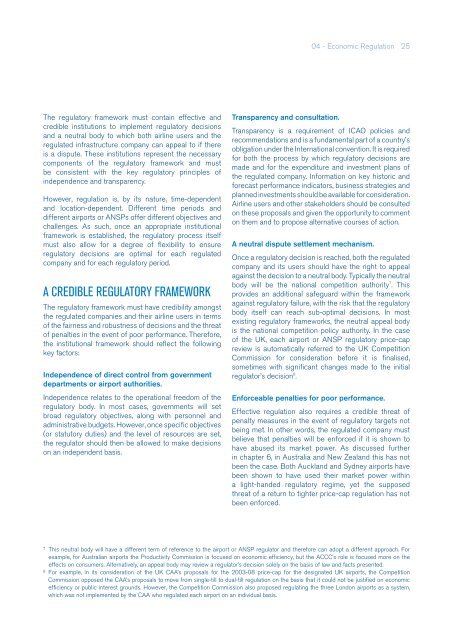Economic Regulation - IATA
Economic Regulation - IATA
Economic Regulation - IATA
You also want an ePaper? Increase the reach of your titles
YUMPU automatically turns print PDFs into web optimized ePapers that Google loves.
04 - <strong>Economic</strong> <strong>Regulation</strong> 25<br />
The regulatory framework must contain effective and<br />
credible institutions to implement regulatory decisions<br />
and a neutral body to which both airline users and the<br />
regulated infrastructure company can appeal to if there<br />
is a dispute. These institutions represent the necessary<br />
components of the regulatory framework and must<br />
be consistent with the key regulatory principles of<br />
independence and transparency.<br />
However, regulation is, by its nature, time-dependent<br />
and location-dependent. Different time periods and<br />
different airports or ANSPs offer different objectives and<br />
challenges. As such, once an appropriate institutional<br />
framework is established, the regulatory process itself<br />
must also allow for a degree of flexibility to ensure<br />
regulatory decisions are optimal for each regulated<br />
company and for each regulatory period.<br />
A CREDIBLE REGULATORY FRAMEWORK<br />
The regulatory framework must have credibility amongst<br />
the regulated companies and their airline users in terms<br />
of the fairness and robustness of decisions and the threat<br />
of penalties in the event of poor performance. Therefore,<br />
the institutional framework should reflect the following<br />
key factors:<br />
Independence of direct control from government<br />
departments or airport authorities.<br />
Independence relates to the operational freedom of the<br />
regulatory body. In most cases, governments will set<br />
broad regulatory objectives, along with personnel and<br />
administrative budgets. However, once specific objectives<br />
(or statutory duties) and the level of resources are set,<br />
the regulator should then be allowed to make decisions<br />
on an independent basis.<br />
Transparency and consultation.<br />
Transparency is a requirement of ICAO policies and<br />
recommendations and is a fundamental part of a country’s<br />
obligation under the International convention. It is required<br />
for both the process by which regulatory decisions are<br />
made and for the expenditure and investment plans of<br />
the regulated company. Information on key historic and<br />
forecast performance indicators, business strategies and<br />
planned investments should be available for consideration.<br />
Airline users and other stakeholders should be consulted<br />
on these proposals and given the opportunity to comment<br />
on them and to propose alternative courses of action.<br />
A neutral dispute settlement mechanism.<br />
Once a regulatory decision is reached, both the regulated<br />
company and its users should have the right to appeal<br />
against the decision to a neutral body. Typically the neutral<br />
body will be the national competition authority 7 . This<br />
provides an additional safeguard within the framework<br />
against regulatory failure, with the risk that the regulatory<br />
body itself can reach sub-optimal decisions. In most<br />
existing regulatory frameworks, the neutral appeal body<br />
is the national competition policy authority. In the case<br />
of the UK, each airport or ANSP regulatory price-cap<br />
review is automatically referred to the UK Competition<br />
Commission for consideration before it is finalised,<br />
sometimes with significant changes made to the initial<br />
regulator’s decision 8 .<br />
Enforceable penalties for poor performance.<br />
Effective regulation also requires a credible threat of<br />
penalty measures in the event of regulatory targets not<br />
being met. In other words, the regulated company must<br />
believe that penalties will be enforced if it is shown to<br />
have abused its market power. As discussed further<br />
in chapter 6, in Australia and New Zealand this has not<br />
been the case. Both Auckland and Sydney airports have<br />
been shown to have used their market power within<br />
a light-handed regulatory regime, yet the supposed<br />
threat of a return to tighter price-cap regulation has not<br />
been enforced.<br />
7<br />
This neutral body will have a different term of reference to the airport or ANSP regulator and therefore can adopt a different approach. For<br />
example, for Australian airports the Productivity Commission is focused on economic efficiency, but the ACCC’s role is focused more on the<br />
effects on consumers. Alternatively, an appeal body may review a regulator’s decision solely on the basis of law and facts presented.<br />
8<br />
For example, in its consideration of the UK CAA’s proposals for the 2003-08 price-cap for the designated UK airports, the Competition<br />
Commission opposed the CAA’s proposals to move from single-till to dual-till regulation on the basis that it could not be justified on economic<br />
efficiency or public interest grounds. However, the Competition Commission also proposed regulating the three London airports as a system,<br />
which was not implemented by the CAA who regulated each airport on an individual basis.

















